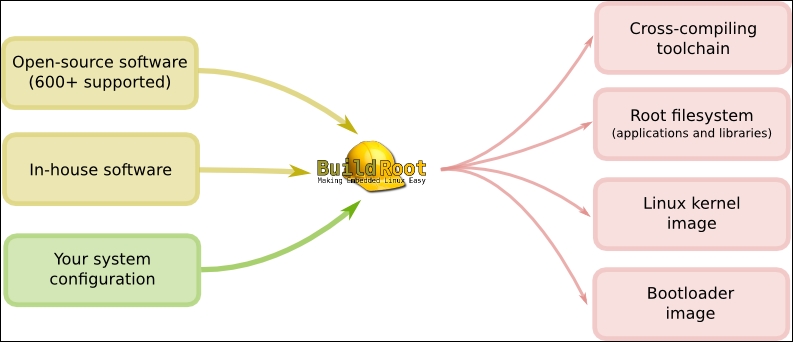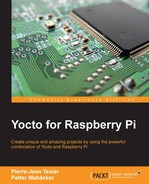In this chapter, we will discover the Yocto Project and its main principles. All the concepts used throughout the book will be introduced here. We will discuss the history of the Yocto Project, the build system, Poky, OpenEmbedded-Core, BitBake, metadata, and the Yocto Project workflow.
The Yocto Project is an umbrella project covering a fairly wide gamut of embedded Linux technologies. It is not a Linux distribution, as explained on the Yocto Project website:
"The Yocto Project is an open source collaboration project that provides templates, tools and methods to help you create custom Linux-based systems for embedded products regardless of the hardware architecture."
Sponsored by the Linux Foundation, the Yocto Project is more than a build system. It provides tools, processes, templates and methods so that developers can rapidly create and deploy products for embedded devices(the Raspberry Pi, Beagleboard, Nitrogen6x, SAMA5D3, Olinuxino, and so on) or QEMU. The two main components that make up the Yocto Project are:
- Poky: This is the build system (the reference distribution).
- BitBake: This is the scheduler. It is a tool based on the Gentoo distribution.
Around November 2010, the Linux Foundation announced that this entire work would continue under the banner of the Yocto Project as a project sponsored by the Linux Foundation (with Richard Purdie, Fellow of the Linux Foundation, as Architect). It was then established that the Yocto Project and OpenEmbedded would coordinate on a core set of package metadata called OE-Core, combining the best of both Poky and OpenEmbedded with an increased use of layering for additional components.
As mentioned before, we are in the world of build systems with the Yocto Project. A build system enables you to:
- Compile or cross-compile applications
- Package applications
- Test output binaries and ecosystem compatibility
- Deploy generated images
To perform these steps, several tools exist. These are some of them:
- Buildroot (http://buildroot.uclibc.org/)
- LTIB (http://ltib.org/)
- OpenWRT ( https://openwrt.org/ )
- Yocto/OpenEmbedded ( https://www.yoctoproject.org/ )
For example, Buildroot is a set of makefiles for automated generation in embedded systems. It supports compiling the bootloader (U-Boot, for example), kernel (zImage or bzImage), and basic controls through BusyBox and third-party applications. Buildroot works on various architectures, such as ARM, x86, and MIPS. For further information, refer to the full documentation in English at https://buildroot.org/docs.html .

"Buildroot is a tool maintained in part by a French company that specializes in embedded Linux development called Free Electrons"
Buildroot is a much more simplistic approach than the one we will discover through this book on the Yocto Project. Buildroot is rather dedicated to firmware generation, while Yocto/OpenEmbedded is oriented towards distribution. Buildroot offers 700 recipes compared to the Yocto Project, which offers over 8000.
